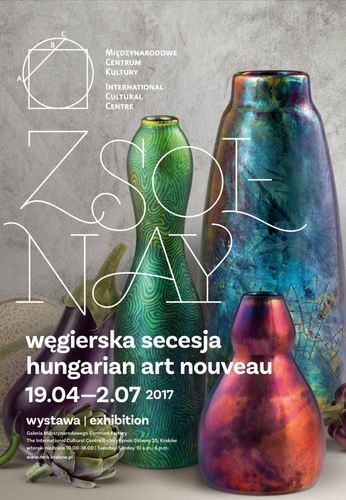Zsolnay: Hungarian Art Nouveau

The phenomenon of the Zsolnay factory, which was based in South Hungary’s city of Pécs, marks an important chapter in the history of Hungarian Art Nouveau movement and an important component in the panorama of art around 1900. The type of objects produced in the factory, which reflected the stylistic tastes of the era, the vision of its owners, as well as the innovations of its technologies, made Zsolnay factory one of the best-known producers of ceramics across Austria-Hungary, as well as Europe at large. Zsolnay’s products were appreciated and collected by Walter Crane, an Arts and Crafts artist. This internationally acclaimed factory (awarded at numerous international exhibitions, including Vienna [1873] and Paris [1878, 1900]) is also an important element of the landscape and identity of Pécs.
The factory’s beginnings date back to the 19th century, when Miklós Zsolnay founded it in Pécs, but its heyday came when it was run by his son, Vilmos. The successive generations of the Zsolnay family – including the Polish engineer Tadeusz (Tádé) Sikorski, who married the owners’ daughter Júlia – developed the factory’s initiatives, actively engaging in the management and development of its products, as well as in the concepts and designs of manufactured objects.
The factory’s heyday came at the turn of the 19th and 20th century. The period’s postulated synthesis of arts and revival of crafts resulted in the involvement of artists in the design of household objects, as well as led to the changes in implemented technological processes. The era of Art Nouveau brought an intense development of ceramics, which due to the plasticity of the material used for its production, offered perfect opportunities for the creation of forms that responded to the stylistic preferences of the era. This trend was perfectly illustrated by the Zsolnay factory, whose products reflected the stylistics of the time (soft lines, sculptural forms, floral and organic ornaments), as well as, significantly, were made with the use of innovative technologies. Zsolnay’s success – next to formally sophisticated objects devised by the factory’s designers who were educated in Budapest and Vienna – was partly achieved thanks to their introduction of the techniques of eosin and pirogranite. The former gave the objects an iridescent, metallic tone. The latter, used in the production of architectonic details, enhanced their durability, endurance, and resistance to weather conditions.
An important sector of Zsolnay’s production, next to decorative and applied ceramics, was the production of elements used for the decoration of numerous buildings across the former Austria-Hungary – their colourful facings adorned roofs, facades, and interiors of public buildings, churches, and private homes. Numerous examples can still be found in many cities in Hungary, Austria, Serbia, and Romania. Among them, the most important examples are works made by Ödön Lechner, one of the key Hungarian artists, who combined elements of Art Nouveau with those of the national style. Objects produced by the Zsolnay family are among the major works of the Art Nouveau applied arts and architecture in Hungary, as well as in the European and global context. They are often compared to objects produced by Louis Comfort Tiffany and Clément Massier.
The exhibition will feature over 100 objects (decorative ceramics, drawings, and architectonic details) from the collection of Janus Pannonius Múzeum in Pécs. This will be the first presentation of the collection and the Zsolnay phenomenon in Poland to date.
Guided tours of the exhibition take place every Sunday:
12 p.m. - in Polish
4 p.m. - in English
This event happens in ICC